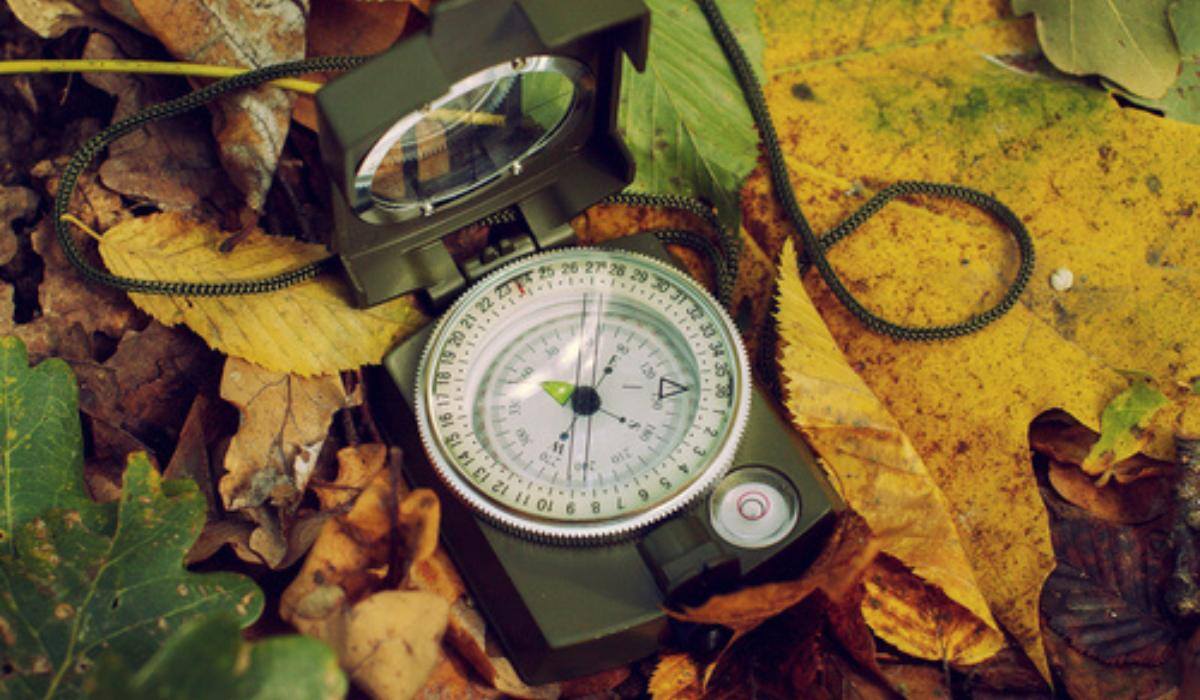
Among the various techniques in surveying, prismatic compass surveying is a practical and efficient method for measuring angles and distances. This technique is crucial in determining 3D positions and angular relationships, forming the backbone of numerous engineering, construction, and mapping projects.
In this article, we’ll delve into the principles, types, and applications of prismatic compass surveying and help you master the fundamentals of this essential surveying method.
What Is a Prismatic Compass & A Prismatic Compass Survey?
A prismatic compass is a specialised compact instrument used in surveying to measure bearings or angles between two points. It comprises a magnetic needle, a graduated circle, and a sighting line. When aligned with a specific line, the magnetic needle naturally points toward the magnetic meridian. The angle between the line and the magnetic meridian can then be read from the graduated circle. However, a compass alone cannot directly measure the angle between two separate lines.
Among the tools used for magnetic bearing measurement, the prismatic compass and the magnetic compass are the two primary instruments. Both help determine bearings and directions during surveying, making them effective tools for navigation.
A prismatic compass survey is a surveying technique that uses the compass to measure angular bearings and chains or tapes to measure distances. This method is ideal for creating detailed maps and layouts of areas by combining angular and linear measurements.
Types of Compass in Surveying
Surveying employs various types of compasses that include:
1. Prismatic Compass

A prismatic compass is a magnetic compass equipped with a prism to facilitate precise observations. It consists of a circular metal box (approximately 100 mm diameter) and a broad magnetic needle. This compass is used to measure whole circle bearings (WCB) of survey lines. Its design allows the simultaneous sighting of objects and reading of bearings.
Consists of the following parts:
-
Cylindrical metal box - The main body of the compass that houses all components. Protects the internal parts from external damage and ensures durability.
-
Pivot - A small, pointed support on which the magnetic needle is balanced. Allows the needle to rotate freely and align with the magnetic meridian.
-
Magnetic needle - A broad, magnetised needle that aligns with the earth’s magnetic field. Indicates the magnetic north and facilitates bearing measurements.
-
Prism - Positioned near the graduated circle for accurate reading of bearings. Magnifies the readings and ensures clear visibility of measurements.
-
Graduated circle - A circular scale marked in degrees from 0° to 360°. Used to measure the angle between a line and the magnetic meridian.
-
Object vane - A vertical vane is used to see the object to be measured. Helps in aligning the compass precisely with the target line.
-
Eye vane - A viewing device through which the surveyor observes the target and reads the bearing.
-
Eye slit and eye hole - Openings on the eye vane that ensure proper alignment of the sighting line.
-
Sunglasses - Small tinted glasses to reduce glare and provide clear visibility during bright conditions.
-
Spring break - A device used to stop the oscillation of the magnetic needle quickly. Ensures stability when taking readings.
-
Reflector mirror - Helps observe the needle’s alignment and reading without shifting the instrument.
-
Focusing stud - Used to adjust the prism for clear and sharp visibility of the graduated circle.
-
Lifting pin and lever - Mechanisms to lift and secure the magnetic needle when the compass is not in use. Prevents unnecessary wear and tear of the needle.
Adjustments in a Prismatic Compass
There are two types of adjustments:
Temporary Adjustments
- Centring: Ensuring the compass is directly over the survey point
- Levelling: Making the compass horizontal using the level
- Focusing the prism for clear readings
Permanent Adjustments
- Aligning the levels
- Adjusting the sight vanes
- Ensuring needle sensitivity
- Straightening the magnetic needle
- Fine-tuning the pivot alignment
2. Survey Compass

The surveyor compass, also known as the circumferentor, is designed for measuring horizontal angles and bearings. It comprises a graduated horizontal circle, a magnetic needle, and a sighting device. The diameter of the graduated ring typically ranges between 50 mm and 200 mm. This compass is primarily used to measure reduced or quadrantal bearings of survey lines.
Consists of the following parts:
- Circular box
- Magnetic needle
- Pivot
- Lifting pin and lever
- Graduated arc
- Glass top
- Sight vane and object vane
- Jewel bearing
- Metal pin
- Rider
3. Level Compass
A level compass incorporates a bubble or spirit level for precise levelling during surveying. The bubble level contains liquid with an air bubble that ensures accurate horizontal alignment of the instrument.
Difference Between Prismatic Compass and Surveyor Compass
Although the prismatic compass and surveyor compass are used for surveying and measuring bearings, they differ significantly in design, functionality, and application. Below is a detailed comparison of the two instruments:
|
Feature |
Prismatic Compass |
Surveyor Compass |
|
Graduation Circle |
Fixed to a broad magnetic needle and does not rotate with the line of sight. |
Fixed to the compass box and rotates along with the line of sight. |
|
Viewing End |
Equipped with a prism for precise observations and reading. |
Has a simple slit at the viewing end with no prism. |
|
Sighting and Reading |
Both sighting and reading can be performed simultaneously. |
Sighting and reading must be done separately, as they cannot be simultaneous. |
|
Magnetic Needle |
Does not act as an index for readings. |
Serves as an index while taking readings. |
|
Graduations |
Uses a whole-circle bearing (WCB) system. |
Uses a quadrantal bearing system, also known as Reduced Bearing (RB). |
|
Markings |
Graduations are inverted as they are read through the prism. |
Graduations are direct and not inverted. |
|
Reading Method |
Readings are observed through the prism for clarity and precision. |
Readings are observed directly from the top glass of the compass. |
|
Tripod Usage |
Can be used with or without a tripod and can even be handheld. |
Requires a tripod for accurate and stable usage. |
Principles of Compass Surveying
Prismatic compass surveying is based on a technique known as traversing, which involves creating a network of interconnected survey lines. The fundamental principles of this surveying method include measuring distances and bearings to map an area accurately.
1. Measurement of Distances and Bearings
Distances between survey points are measured using a chain or tape. Magnetic bearings of survey lines are recorded using the prismatic compass, which simplifies the process without needing triangulation.
2. No need for Triangulation
Unlike other surveying methods, prismatic compass surveying does not require forming a network of triangles. Instead, it relies solely on the direct measurement of distances and bearings.
3. Identifying Interior Details
Interior details of the surveyed area are determined by deriving offsets from the main survey lines. These offsets help pinpoint specific features within the survey area.
4. Use of Subsidiary Lines
In some cases, subsidiary lines are added to the survey to provide additional accuracy and detail for mapping complex features.
5. Methods of Traversing
Traversing can be conducted using various instruments and techniques, depending on the survey requirements. Common methods include:
Compass Traverse: Using a prismatic or surveyor compass for bearings.
Plane Table Traverse: Using a plane table for direct plotting in the field.
Stadia Traverse: Measuring distances with a tachometer or stadia rod.
Theodolite Traverse: Employing a theodolite for highly accurate angular measurements.
Prismatic Compass Surveying Instruments Used
1. Prismatic Compass
- A primary instrument used to measure magnetic bearings of survey lines.
- Equipped with a magnetic needle, graduated circle, and a prism for clear sighting and reading.
- Compact and portable, ideal for field surveys requiring angular measurements.
2. Tape
- Used for measuring horizontal distances between survey points.
- Available in different materials such as steel, fibreglass, or linen.
- Ensures accurate linear measurements to complement the angular readings.
3. Ranging Rods
- Long rods, typically painted in alternating red and white bands, are used to mark survey points.
- Aid in aligning and sighting points during traversing.
- Lightweight and easy to transport in the field.
4. Tripod
- Provides a stable platform for mounting the prismatic compass.
- Adjustable legs allow levelling of the compass on uneven ground.
- Ensures precision by minimising instrument movement during measurements.
5. Arrows
- Metal pins are used to mark measured distances on the ground during chain or tape measurements.
- Helps maintain consistency and accuracy while measuring long lines.
- Typically sharp-pointed for easy insertion into the ground.
6. PLumb Bob
- A pointed weight suspended on a string is used to ensure vertical alignment.
- Assists in centring the compass precisely over the survey point.
- Ensures accurate positioning during measurements.
By utilising these instruments in conjunction, prismatic compass surveying achieves accurate and efficient measurements, making it a reliable method for field surveys.
Applications/Uses of Prismatic Compass
This method is particularly useful in situations where other surveying techniques, like chain surveying, might be impractical. Some key scenarios include:
- Surveying large areas such as river courses or coastal regions, where linear measurements alone are insufficient.
- Calculating differences in elevations using angle measurements.
- Challenging terrains with numerous obstacles that make triangulation difficult, such as dense vegetation or uneven ground.
- Time-sensitive projects, where extensive surveying needs to be completed quickly without compromising accuracy.
Limitations
It is unsuitable for areas with magnetic interference, such as locations near iron ore deposits, metallic structures, or active electric cables. Magnetic substances can disrupt the accuracy of the compass readings.
Avoiding public areas where disturbances may impact the survey is often necessary.
It may not deliver precise results in environments with strong magnetic anomalies or heavy industrial infrastructure.
Advantages of Prismatic Compass
1. Portability:
- The prismatic compass is compact, lightweight, and designed for easy transportation.
- Its portability makes it ideal for surveys in challenging terrains, such as remote forests, mountainous areas, or construction sites where larger, heavier instruments would be impractical.
- It is particularly beneficial for projects requiring frequent movement between survey stations.
2. Simple Setup:
- Unlike more advanced instruments, the prismatic compass requires minimal setup and adjustments.
- It can be quickly fixed at a station, allowing surveyors to save time, especially in time-sensitive projects.
- This simplicity reduces the chances of errors during setup and makes it user-friendly for beginners.
3. Independent Lines:
- Each survey line’s measurement is independent of others, meaning an error in one line does not impact the accuracy of the rest.
- This characteristic ensures that localized errors remain confined, preserving the overall reliability of the survey.
- It is especially advantageous in surveys with numerous interconnected lines, reducing the risk of cumulative errors.
4. Retracing Old Surveys:
- The prismatic compass is highly effective for revisiting and verifying previous surveys, as bearings measured in past surveys can be easily compared with current readings.
- This capability is essential for updating old maps, checking historical data, or verifying changes in terrain or infrastructure over time.
5. No Power Requirement:
- Operating entirely on magnetic principles, the prismatic compass does not require any external power source, batteries, or electronic components.
- This makes it reliable in remote or off-grid locations where electricity is unavailable.
- Its independence from power also makes it resilient to technological failures or environmental conditions that might affect electronic equipment.
Disadvantages of Prismatic Compass
Lower Precision: The method is less accurate compared to modern surveying techniques such as theodolite or total station surveys.
1. Susceptibility to Errors
Readings are affected by factors such as:
Magnetic declination: Variations in the Earth’s magnetic field can lead to errors in bearings.
Local attraction: Nearby magnetic materials or electric currents can distort the magnetic needle's alignment.
2. Human Errors
Mistakes in sighting ranging rods, improper levelling of the compass, or incorrect adjustments can lead to inaccuracies.
3. Environment Limitations
The compass's functionality is heavily influenced by its surroundings, limiting its use in areas with high magnetic interference or unstable terrains.
Conclusion
With portability, ease of use, and the ability to measure whole-circle bearings, prismatic compass surveys are essential for field surveys, especially in remote and challenging terrains. While modern technologies have introduced advanced surveying instruments, the prismatic compass remains a reliable and straightforward option for many applications. As surveying techniques continue to evolve, the prismatic compass will retain its significance as a foundational tool, providing essential data that supports accurate mapping and land development.
If you're curious about the prismatic compass survey and want to learn more about it, explore the BIM Professional Course for Civil Engineers offered by Novatr and see how it aligns with your professional aspirations.
For more information on civil engineering and related topics, head to our Resources Page.
Was this content helpful to you



.jpg)






